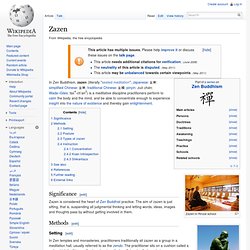

Zen Is Boring. This was not written by me.

This page where this post originally showed up was online at: but doesn’t show up anymore, so here it is. Edit: someone recently commented saying this is by Brad Warner. I can’t find it posted on his site, but in the case that it was written by him, thank you Brad! Either way, his Hardcore Zen work is awesome. “Let’s face it. Joshu Sasaki, a Zen teacher from the Rinzai Sect, once said that Buddhist teachers always try to make students long for the Buddha World, but that if the students knew how really dry and tasteless the Buddha World actually was, they’d never want to go. Boredom is important. People hate their ordinary lives. Your life will change. People long for big thrills. You need a teacher like that. Boredom is what you need. Some years ago some psychologists did a study in which they sat some Buddhists monks and some regular folks in a room and wired them up to EEG machines to record their brain activity.
How to do Zazen - Seated Meditation Video. Hi, I am Patrick and today we are talking about Zazen and how to do it.

Meditation isn't just for buddhas or monks; it's for everybody that can be done at almost any time. So let's get started. When you sit, you are going to want to elevate your pelvis. The most useful thing for this is something like a Zafu, it's a round Japanese shape. But honestly anything will work, a pillow folded in half, a rolled up blanket is just as good. As you sit, you want to have a stable base as possible. And finally, classic full-lotus posture. Most important physical component of meditation is the spine. Another thing to look out for is the shoulders. Zazen can be done from anywhere between 15 minutes to one hour. The idea of the zazen is to have a clear empty mind without chattering thought. Like a monkey you are constantly climbing from tree to tree, the mind meets some random thoughts or random thought.
I am only half as serious with these actions and things. Shikantaza. Shikantaza (只管打坐?)

Is a Japanese translation of a Chinese term for zazen introduced by Rujing, a monk of the Caodong school of Zen Buddhism. In Japan, it is associated with the Soto school. Etymology[edit] The term is believed to have been first used by Dōgen's teacher Tiantong Rujing, and it literally means, "nothing but (shikan) precisely (da) sitting (za). A translation of "shikantaza" offered by Kobun Chino Otogawa[6] provides some additional insight into the literal meaning of the components of the Japanese word: Shikan means pure, one, only for it.
Origins and development[edit] Samatha. Zazen. In Zen Buddhism, zazen (literally "seated meditation"; Japanese: 坐禅; simplified Chinese: 坐禅; traditional Chinese: 坐禪; pinyin: zuò chán; Wade–Giles: tso4-ch'an2) is a meditative discipline practitioners perform to calm the body and the mind, and be able to concentrate enough to experience insight into the nature of existence and thereby gain enlightenment.

Zazen in Rinzai school Kosho Uchiyama writes that Auguste Rodin's The Thinker, in which the "back, waist, legs, arms, and even fingers" are curled up, is the opposite of zazen posture.[1] Significance[edit] Zazen is considered the heart of Zen Buddhist practice. The aim of zazen is just sitting, that is, suspending all judgmental thinking and letting words, ideas, images and thoughts pass by without getting involved in them.
Methods[edit] Setting[edit] In Zen temples and monasteries, practitioners traditionally sit zazen as a group in a meditation hall, usually referred to as the zendo. Posture[edit] Types of zazen[edit] Instruction[edit]